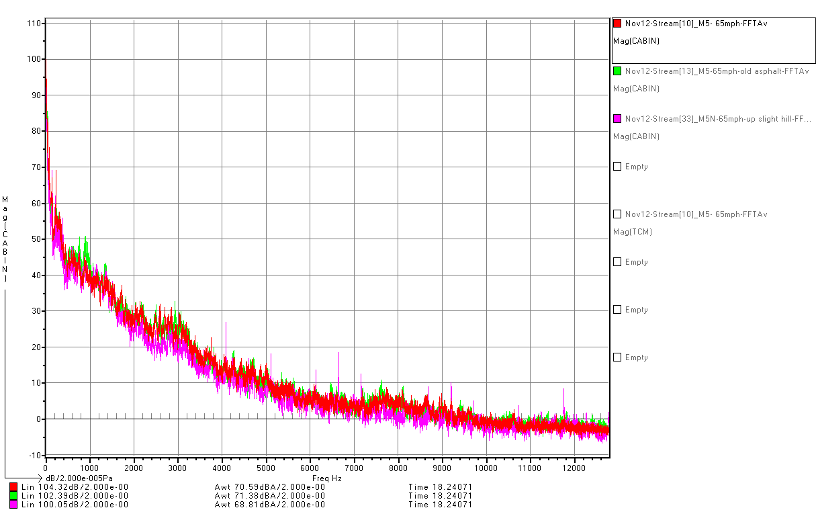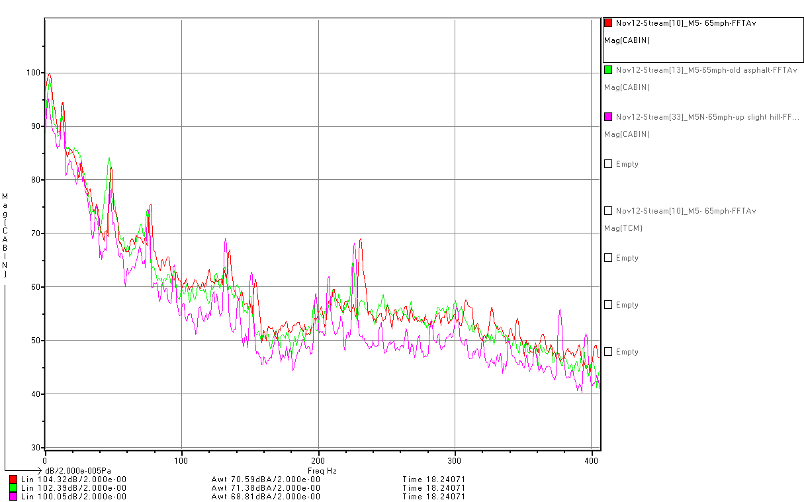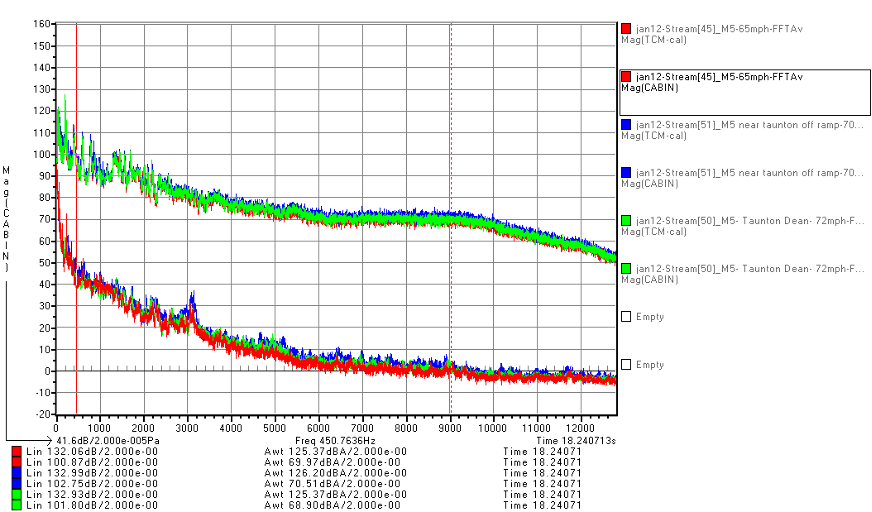A tire study has investigated if there can be a good agreement between rolling road and real road measurements
Part 1: recap
Driving at speeds <50mph (80km/h) revealed that for light throttle the driven and undriven tires generated essentially the same level of cavity resonance tones. On a 1:20 incline at 45mph (72km/h) the driven wheel’s PCR tone was some 4dB higher in level.
Click here to read part 1 online.
Part 2: Motorway measurements
Leaving the local road system and joining the M5 motorway and increasing speed to an indicated 65mph* (104km/h) produced some interesting differences between driven and undriven tires (Figure 5). The overall linear level inside the driven wheel increases to 142dB but the undriven remains at 133dB. The driven wheel’s level is therefore some 9dB higher than at 45mph (72km/h). The undriven wheel’s internal noise remained unchanged even though the speed increased by 20mph (32km/h) to 65mph (104km/h).

The 20mph (32km/h) increase in speed requires more power, lifting the level of all noise components by approximately 9dB. The cabin levels for the two runs show close agreement in spectral shape and overall Awt level. The cabin PCR level was higher in the undriven case, indicating that the imperials may be generating higher PCR levels and that the rear suspension provides less isolation.

A quality check was therefore performed to confirm the 9dB difference between driven and undriven wheels, being due to the power transmitted rather than a change in road surface. Two other 65mph (104km/h) driven wheel recordings were examined (Figure 7). The result from a stretch of older asphalt was some 7dB noisier and the measurement made on a slight upward incline was 1.5dB noisier than the DW (stream 10) level used in the comparison. Therefore, the DW (stream 10) selected for the comparison of DW/FW at 65mph (104km/h) was one of the quietest at 142dBLin and 136dBA for the M5.

Cabin noise levels (Figure 8) for the same three recordings show that although the stream 10 recording was the quietest for in-wheel noise, it was the loudest, by +2dBLin, for in-cabin noise but only 1.5dBA higher. The PCR peak levels varied by 5dB (69dB, 64.4dB and 68.2dB) (Figure 9).


Making a similar comparison for the undriven (FW) set of runs at speeds from 62mph (99km/h) to 72mph (115km/h), the agreement was closer with the in-tire overall level of 132, 134 and 134dBLin and 125, 125 and 126dBA. The in-cabin dBLin levels were 100.9, 102.8 and 101.8dBL, essentially 101 ±1dB and the dBA levels 70 ±1 dBA (Figure 10). Looking more closely at the PCR levels and higher cavity modes (Figure 10), the very close agreement between the three different FW runs at slightly different speeds (streams 45, 51 and 50) can be seen in Figure 11.


Discussion
At speeds over 60mph (96km/h), the driven wheels are doing significantly more work than the undriven and this is reflected in the 10+dB higher levels of the SPL spectra measured inside the tires.
The change in SPL inside the tire for three different stretches of motorway road surface was less than 6dB for the driven wheel and less than 1dB for the undriven wheel. This indicates that the power running through the tire was much more important than the surface being driven over.
In the next installment: Comparison of road and rolling road data
*Indicated speeds were +3mph (5km/h) more than the actual speed reported by GPRS navigation. All speeds reported in this note are indicated speeds. The TCM was always inside the Nokian tire, the tires moved from back axle on November 12 to front axle on January 12.


